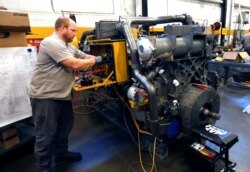Today’s American men are working less during their prime years than they did in the 1960s, with the biggest drop in employment among less-educated men.
In 1969, 96% of men between the ages of 25 and 54 participated in the labor force. By 2015, that rate had fallen to under 89%.
The U.S. Bureau of Labor Statistics studied two generations of non-working men. The first group was made up of men born between 1960 to 1964. The second group of men between 1980 to 1984.
Across both generations, the nonworkers had some attributes in common. They were more likely to be unmarried and living with their parents than their working counterparts.
“They have lower AFQT [Armed Forces Qualification Test] scores. They're less likely to have a bachelor's degree, more likely to have lower levels of education,” says Donna Rothstein, a research economist at the U.S. Bureau of Labor Statistics. “It's not that they were more likely to be enrolled in school or something else that might indicate that they were doing some other activity.”
Nonworkers were more likely to be black. About one-third of nonworkers were black.
While the biggest employment drop is among less-educated men, the troubling trend now seems to be occurring among women as well. Female employment rates rose beginning in the late 1960s, but then started dropping.
“Since about 2000, you're also starting to see declines in participation of prime-age women, especially less educated women,” says Katharine G. Abraham, author of the study and a professor of economics and survey methodology at the University of Maryland. “So you're kind of seeing some of the same things that have been happening for a longer time to men, also beginning to happen to women.”
A changing labor market, particularly the steep decline of manufacturing jobs in the United States, has hit this group of workers particularly hard.
“If you're a less-educated worker, it used to be that you could get a good job. Maybe you’d work in manufacturing, maybe you'd work in construction. You could have a good job without necessarily having a college education. But the labor markets really changed,” says Abraham. “For a lot of these less-educated men and, women, both of their opportunities in the labor market are less good. They can't expect to earn the same kind of living that their fathers might have.”
Experts suggest that the rise in incarceration, and the growth in the number of people with prison records, negatively contribute to the ability of some of these non-working men to get a job.
“People who did not work in the prior year were more likely to be interviewed while they were in prison,” Rothstein says. “Twenty-four percent of the people in group one [men born between 1960 to 1964], almost one-in-four, didn't work because they were in prison.”
Researchers have also studied the possible impact of the opioid epidemic on labor force participation. More than 130 people in the United States die each day after abusing opioids. Opioid overdoses caused more than 42,000 deaths in 2016.
“We know that they're correlated, but what I think we don't really know is whether the opioids are causing the lower labor force participation rate,” Abraham says. “For some people, it could make it more possible for them to work. If they're better able to control pain.”
Abraham, who has authored a paper on the decline in U.S. employment, says it’s important not to underestimate the impact that increasing globalization is having on men and women who are supposed to be in the prime of their working lives.
Solutions for tackling the problem could include making sure young people are educated to acquire skills that will serve them well in the labor market. Older workers might need to invest in shorter-term skill acquisition.
“Maybe we could think about wage subsidies for people. We've done that a little bit in the past with people who are displaced due to trade,” Abraham says. "Maybe we could think about expanded public sector employment investment in our deteriorating infrastructure...if you think about government solutions, then you're talking about really investing in these people.”











